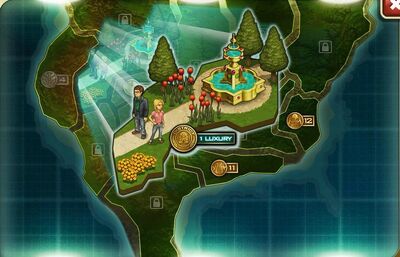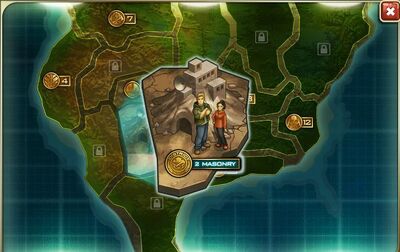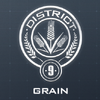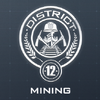The nation of Panem was separated into a total of thirteen nation-states known as districts, twelve of which are recognized as operational by the Capitol, and each being responsible for producing, procuring, or refining goods in a particular industry as dictated by the Capitol. All of the districts are subject to the unrelenting will of the authoritarian Capitol, and have no known influence concerning the national politics of Panem beyond their own individual territories.
The districts barely interact with each other since it was illegal, so each district generally has a unique culture unaffected by the other districts. Welfare levels vary significantly, and are often dependent on the goods it produces; some districts, such as 10, 11 and 12, are far more impoverished than wealthier districts like 1, 2, and 4, though apparently no district is nearly as wealthy as the Capitol itself.
Originally, there were thirteen districts in Panem. During the Dark Days, District 13 was obliterated by the Capitol and is no longer recognized as operational. Each district provides something different to the Capitol; for example, District 12 provides coal and District 4 provides fish.
District 1
District 1’s industry is making luxury items for the Capitol. Due to the nature of its industry, it’s considered to be the wealthiest district, the only other wealthier area being the Capitol itself. It is a Career District. Little else is known about this district. At the end of Mockingjay, memorials were made for the fallen tributes and victors from District 1, meaning District 1 has 148 of Panem’s memorials in their district, notable ones being Cashmere, Gloss,Glimmer and Marvel.
According to the Panem map shown in The Hunger Games Adventures, it is located north of the Capitol.
District 2
District 2’s industry is masonry, but also manufactures weaponry, makes trains, and suppliesPeacekeepers. The main military complex in the district is known as the Nut. Citizens of District 2 are sometimes called “the pets” of the Capitol. They are the biggest supporters of the Capitol and therefore are pampered and given many extra conveniences. Some notable tributes are Clove, Cato, Enobaria and Brutus.
According to the Panem map shown in The Hunger Games Adventures and The Hunger Games: Catching Fire, it is located south/southeast of the Capitol.
District 3
District 3’s primary industry is general electronics of many types, though it is known for also making various mechanical products such as automobiles and firearms. Their tributes are skilled with electronics. Some notable tributes are Wiress and Beetee.
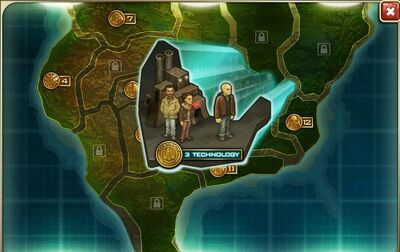 According to the Panem map shown in The Hunger Games Adventures, District 3 is located northwest of District 12, which explains the fact that District 3 is not a Career District.
According to the Panem map shown in The Hunger Games Adventures, District 3 is located northwest of District 12, which explains the fact that District 3 is not a Career District.
District 4
District 4’s industry is fishing, thus most residents have experience using nets and tridents, making fishhooks from scratch, swimming, and identifying edible sea life. It is considered aCareer district. Finnick Odair, Mags, and Annie Cresta came from this district. Finnick was an important ally of Katniss Everdeen in the Quarter Quell. According to the Mockingjay podiums, District 4 has 6 victors.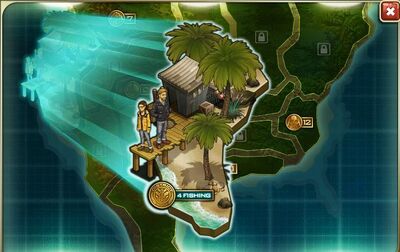
According to the Panem map shown in The Hunger Games Adventures and The Hunger Games: Catching Fire, it is located on the west coast of North America around California and Oregon.
District 5
District 5’s industry is power. Foxface, a clever tribute nicknamed by Katniss in the 74th Hunger Games, was from District 5. In the 75th Hunger Games the man from District 5 was the first person to die, while he attacked Katniss.
According to the Panem map shown in Catching Fire, it is located fairly close to the Capitol, only a little bit southwest of it.
District 6
District 6’s industry is transportation. In the 75th Hunger Games, two of the past winnersended up becoming morphling addicts. Another known tribute from District 6 was Titus. Little else is known about District 6. According to the Mockingjay podiums, District 6 has 4 victors.
According to the Panem map shown in Catching Fire, it is located directly under Lake Michigan.
District 7
District 7’s industry is lumber and many of its residents have experience with hatchets, axes, saws, and other tree cutting tools. Also, Katniss notes that this district’s children begin work at an early age. Katniss and Peeta had to travel through District 7 to get to the Capitol.Johanna Mason and Blight came from this District. According to the Mockingjay podiums, District 7 has 7 victors.
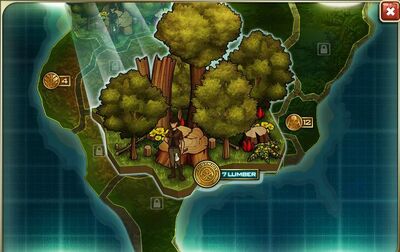 According to the Panem map shown in The Hunger Games Adventures and The Hunger Games: Catching Fire, it is located in the upper north region, near District 4.
According to the Panem map shown in The Hunger Games Adventures and The Hunger Games: Catching Fire, it is located in the upper north region, near District 4.
District 8
District 8’s industry is the production of textiles, and they have at least one factory that is primarily used for making Peacekeeper uniforms. It was the first district to rebel after Katniss Everdeen spurred the revolution. The rebellion worsened conditions for residents and some, including Bonnie and Twill, escaped. However, Bonnie and Twill never made it to safety in District 13. Cecelia and Woof were victors from District 8. According to the Mockingjay podiums, District 8 has 4 victors.
According to the Panem map shown in Catching Fire, it is located south of Lake Ontario.
District 9
District 9’s industry is grain. Little is known about this district, just that there are lots of farmland for grain. In the 74th Hunger Games, the boy from District 9 was the first person to be killed in the book. According to the Mockingjay podiums, District 9 has 5 victors.
According to the Panem map shown in Catching Fire, it is located northeast of District 10, near the Great Lakes.
District 10
District 10’s industry is livestock. Not much is known about this district, but some known information is that its marriage rituals are similar to that of District 4’s. In the 74th Hunger Games, Katniss names the boy from District 10 “the boy with the bad leg” as he was crippled. Katniss and Peeta had to travel through District 10 also to get to the Capitol.
According to the Panem map shown in Catching Fire, it is located in the southern area of North America.
District 11
District 11’s industry is agriculture – orchards and fields of grain and cotton surround the district. Almost everything grown is shipped directly to the Capitol. It is one of the poorest districts in Panem, second only to District 12. In addition, it is also one of the districts where the Peacekeepers are the strictest. Ironically, this directly results in its residents generally being malnourished and underfed despite its focus on agriculture. In Catching Fire, Katniss said on her and Peeta’s Victory Tour, that District 11 is south of District 12. District 11 is located somewhere near Atlanta and is quite large. Rue and Thresh were notable tributes. Seeder and Chaff were victors from District 11. According to the Mockingjay podiums, District 11 has 5 victors.
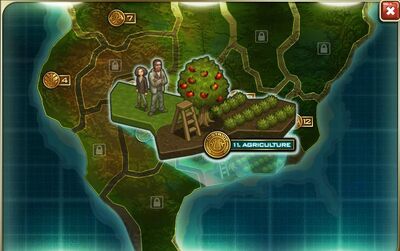
District 11 as it appears in The Hunger Games Adventures
According to the Panem map shown in Catching Fire, it is located where Florida is currently at today. Although in The Hunger Games Adventures, Florida is submerged, and District 11 is located south of Panem, where Mississippi is today.
District 12
District 12’s industry is coal. District 12 is located somewhere near what was the Appalachian mountains. The district has the distinction of being one of the poorest districts, if not the outright poorest, in all of Panem. Before Katniss Everdeen and Peeta Mellark won the 74th Hunger Games, the district has not had a winner of the Hunger Games emerge from the ranks of its residents for twenty-four years since Haymitch Abernathy, a raging alcoholic and an embarrassment to the district, won the 50th Hunger Games. Before Haymitch, there was only one other victor from District 12 from an unspecified number of years previous. District 12 is the laughing stock of Panem. Shortly after the abrupt end of the 75th Hunger Games and during the opening hours of the second rebellion, District 12 was destroyed by the Capitol, using firebombs. Less than 900 people escaped, mostly thanks to the foresight of Gale Hawthorne. At the end of the second rebellion, District 12 starts to rebuild. According to the Mockingjay podiums, District 12 has 3 victors; however in the book it was revealed District 12 has 4.
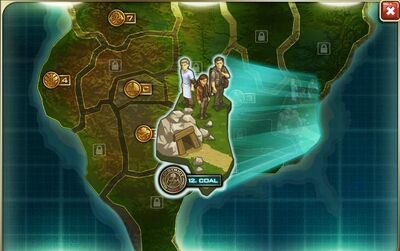
District 12 as it appears in The Hunger Games Adventures
According to the Panem map shown in The Hunger Games Adventures and The Hunger Games: Catching Fire, it is located in the Appalachian Mountains in the Carolina’s.
District 13
District 13 was one of the thirteen districts of Panem. Its main industry was nuclear weaponry. It was supposedly obliterated during the Dark Days as a warning to the other twelve districts of the Capitol’s might. The district is now said to be uninhabitable with the ruins supposedly still smoldering from the toxic bombs dropped upon it.
After the Dark Days, the Capitol lead Panem’s population to widely believe that the main industry of District 13 was graphite mining. However, this was a cover for the truth: nuclear technology research and development, including weapons.
It is revealed in Mockingjay that the district is in actuality still operational, though it has seceded from the nation of Panem and operates covertly. While the surface of District 13 remains scarred and supposedly uninhabitable, its residents live deep underground, hidden away from the world and the eyes of the Capitol. It is used as a base for the Second Rebellion. The Capitol leaves District 13 alone due to a non-aggression pact, and none of its citizens participate in The Hunger Games due to this.
Career districts
Many of the wealthier districts such as Districts 1, 2 and 4, known as “Career Districts,” have a more positive orientation toward the Hunger Games. As residents do not generally face extreme poverty and malnutrition as is done in more impoverished districts, their tributes are generally healthy and strong. In these districts, it is not uncommon for children to volunteer to be tributes, as winning the Hunger Games is held in highest regard in these districts. Although it is against the rules of the Hunger Games, children in these districts are often specifically raised to participate in the Hunger Games, and thus are trained in the arts of combat and survival. They are typically known as Career Tributes, or “Careers” for short.


